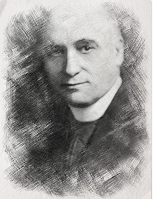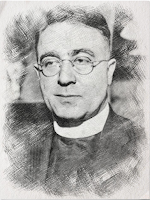As we saw in the previous posting on this subject, we saw that the New Deal really had nothing to do with any natural law-based approach to social thought, or even “supernatural law” approach, either, if we accept Dorothy Day’s strictures about the dangers of giving “Holy Mother, the State” such overwhelming power.
That didn’t matter to Msgr. John A. Ryan and Fr. Charles Coughlin, though, both of which in slightly different ways virtually worshipped the State. Not that two such strong personalities could get along for very long before having a falling out.
On the other hand, while it lasted, the Ryan-Coughlin alliance was extremely influential within the Church, joining the interests of Academics, the clergy, and “pew Catholics,” and deflecting charges of anti-Semitism. In 1933, for example, in an article praising Coughlin, Dr. Harry Elmer Barnes (1889-1968) of Columbia University, the noted historical revisionist and holocaust denier, made a point of stating that the blue-collar Coughlin had the academic Ryan’s support.
 |
| Msgr. John A. Ryan |
Barnes implied that both Coughlin’s and Ryan’s thought was consistent with that of the agrarian socialist Henry George (Dr. Harry Elmer Barnes, “Father Coughlin,” The Pittsburgh Press, December 24, 1933, 4),who (despite George’s attacks on Leo XIII) still had many Catholic supporters. A few weeks later Ryan publicly endorsed Coughlin:
Msgr. John Ryan, outstanding Catholic sociologist and member of the faculty of the Catholic University of America. Washington, D.C., has come out for Father Coughlin. Ryan says that while he does not agree with everything the radio priest has said, he feels Father Coughlin is “on the side of the angels” and is especially to be complimented for his work in stirring up the masses. (Donald Pond, “The Crusader of the Air: Boos for Al [Smith] Mark Father Coughlin’s Attack on ‘Happy Warrior’,” The Pittsburgh Press, January 9, 1934, 21.)
 |
| Fr. Charles E. Coughlin |
Ryan’s admiration of Coughlin lasted until the latter attacked the second phase of the New Deal. Despite the fact that Coughlin’s attitudes and opinions about “the Jews” were widely known prior to Coughlin’s break with Roosevelt, Ryan did not criticize them until Coughlin attacked the New Deal, ending his utility to Roosevelt. Coughlin then changed from being “on the side of the angels,” to “90 per cent wrong.”
(“Monsignor Raps Father Coughlin: The Right Rev. John A. Ryan Speaks Under Democratic Auspices,” The Spokesman-Review, October 9, 1936, 2. ; “Coughlin’s Criticism of Jews Denounced,” The Pittsburgh Press, August 19, 1936, 1, 4. Ryan’s views on racism appeared to be somewhat flexible. He gave a talk at Howard University on March 2, 1943 in which he insisted that segregation (“Jim crow”) was essential to prevent intermarriage of Blacks and Whites. (Michael Carter, “Colored Girls May Not Live in Catholic University Dorms: Rev. John Ryan Says Two on Campus Are Haitians, but That Is Different,” Baltimore Afro-American, March 20, 1943, 14.) At one point during the talk Ryan told a joke employing “the N Word,” whereupon “The audience gasped. That epithet had not been heard at Howard University in a good many years from the platform.” (“H.U. Gasps as Monsignor Uses Epithet,” Baltimore Afro-American, March 20, 1943, 14.)
Archbishop Michael Joseph Curley
Like the McGlynn-George quarrel fifty years previously, the dispute was widely reported in the national media and became bitter and acrimonious. (“Father Coughlin Will Answer Monsignor Ryan,” Lewiston Daily Sun, October 2, 1936, 1.) Archbishop Michael Joseph Curley (1879-1947) of Baltimore called on both Ryan and Coughlin to “do a great favor to the church and to the country at large” by “retir[ing] for some time to the Carthusian order, where perpetual silence is observed.” (“Church Organ Raps Priests: Paper Says Coughlin And Ryan Should ‘Rest A While’,” Reading Eagle, October 16, 1936, 2; “Coughlin and Ryan Asked to ‘Shut Up’,” The Florence Times, October 16, 1936, 1.)
During a visit to the United States, the future Pius XII refused to have anything to do with either of them (“Cardinal Pacelli Arrives in New York for Visit,” Lewiston Daily Sun, October 2, 1936, 1.). Speculation — first denied (“Papal Aide to Sail on Trip to America: Vacation Trip to Be Incognito, With Coughlin’s Activities Not a Factor,” The Washington Star, October 1, 1936, A-12), later confirmed (Joseph Alsop and Robert Kintner, “The Capital Parade: Passage in Pope’s Encyclical Declared Rebuke for Coughlin,” The Washington Star, November 15, 1939, A-11) — was rife that at least one reason for the visit was to investigate the confusion being spread by the two unofficial and self-appointed authorities on Catholic social thought (Pacelli Sails for America: Papal Secretary’s Visit Linked With Coughlin,” The Times-News, Hendersonville, North Carolina, October 1, 1936, 1.). A passage in Sertum Laetitiae, Pius XII’s 1939 encyclical to the Church in the United States (Sertum Laetitiae, § 30), was widely interpreted “as a direct rebuke to Father Charles E. Coughlin.” (Alsop and Kintner, “The Capital Parade,” op. cit.)
 |
| Pope Pius XII |
Significantly, Ryan’s 1941 autobiography makes only two very brief and non-committal references to Cardinal Pacelli/Pius XII. (Ryan, Social Doctrine in Action, op. cit., 263, 285.) As Vatican Secretary of State from 1930 to 1939 before his election to the papacy, Pacelli — who favored and supported Fulton Sheen over Ryan — would have been chiefly responsible for dealing with the controversies stirred up by Ryan at the Catholic University of America.
With Hitler’s rise to power, the voice of social Catholicism in Germany and, soon after, in Austria was stilled. There were no independent movements in Italy, Spain, or Portugal, while in the countries conquered by the Nazis, those Catholic social leaders who were not arrested went into hiding or exile. This left the Catholic social thought of America, under the control of Ryan, in a dominant position. As Mueller noted,
Perhaps the only nation in which the Catholic social movement — and a “movement” it now was — could continue to operate with almost undiminished vigor was the United States. Under the leadership of John A. Ryan social Catholicism in this country enjoyed during the depression something approaching official recognition. . . . Ryan rose, in a manner, to be the architect of social legislation in this country, enjoying the special confidence of President Franklin D. Roosevelt. (Mueller, The Church and the Social Question, op. cit., 117-118.)
#30#

